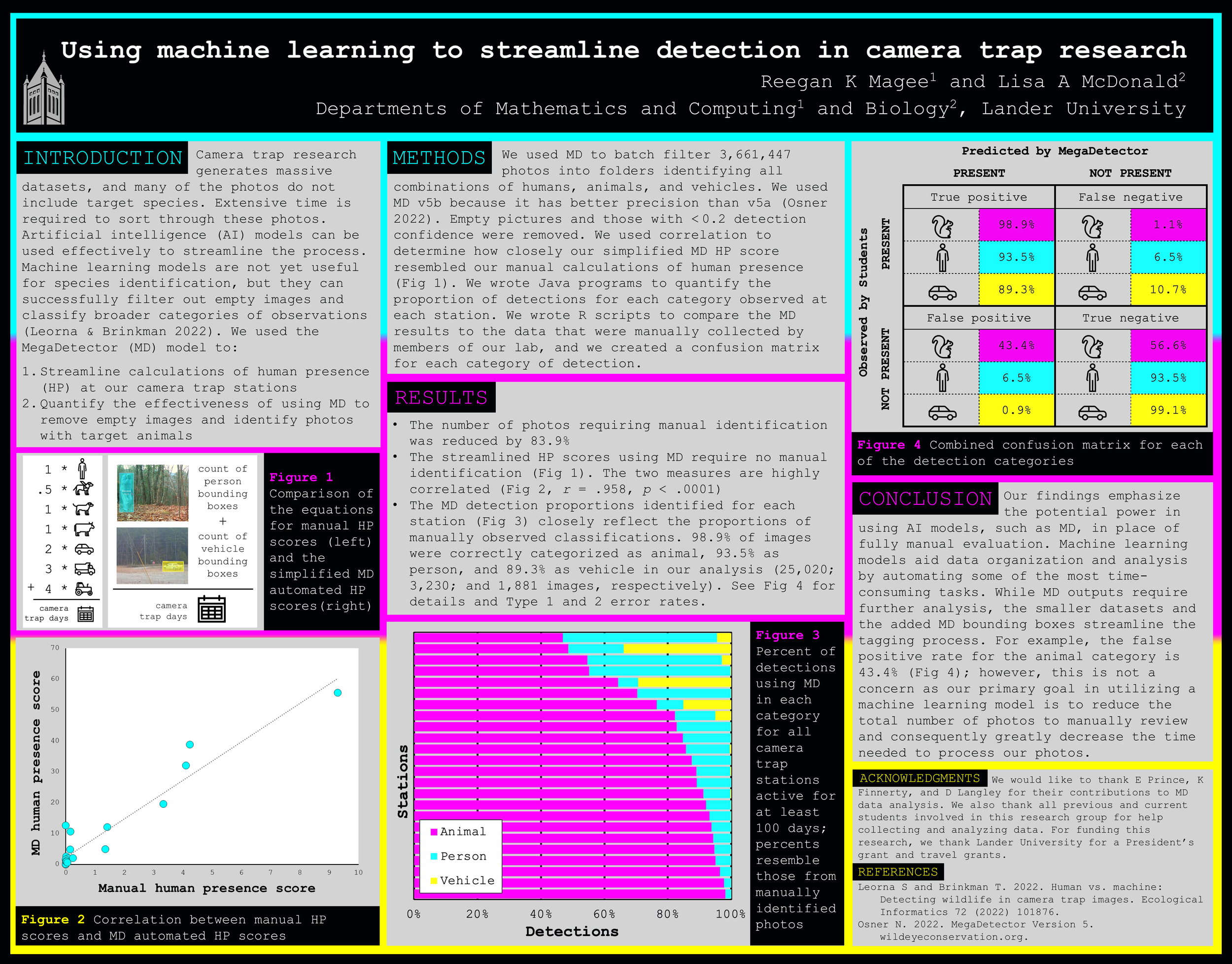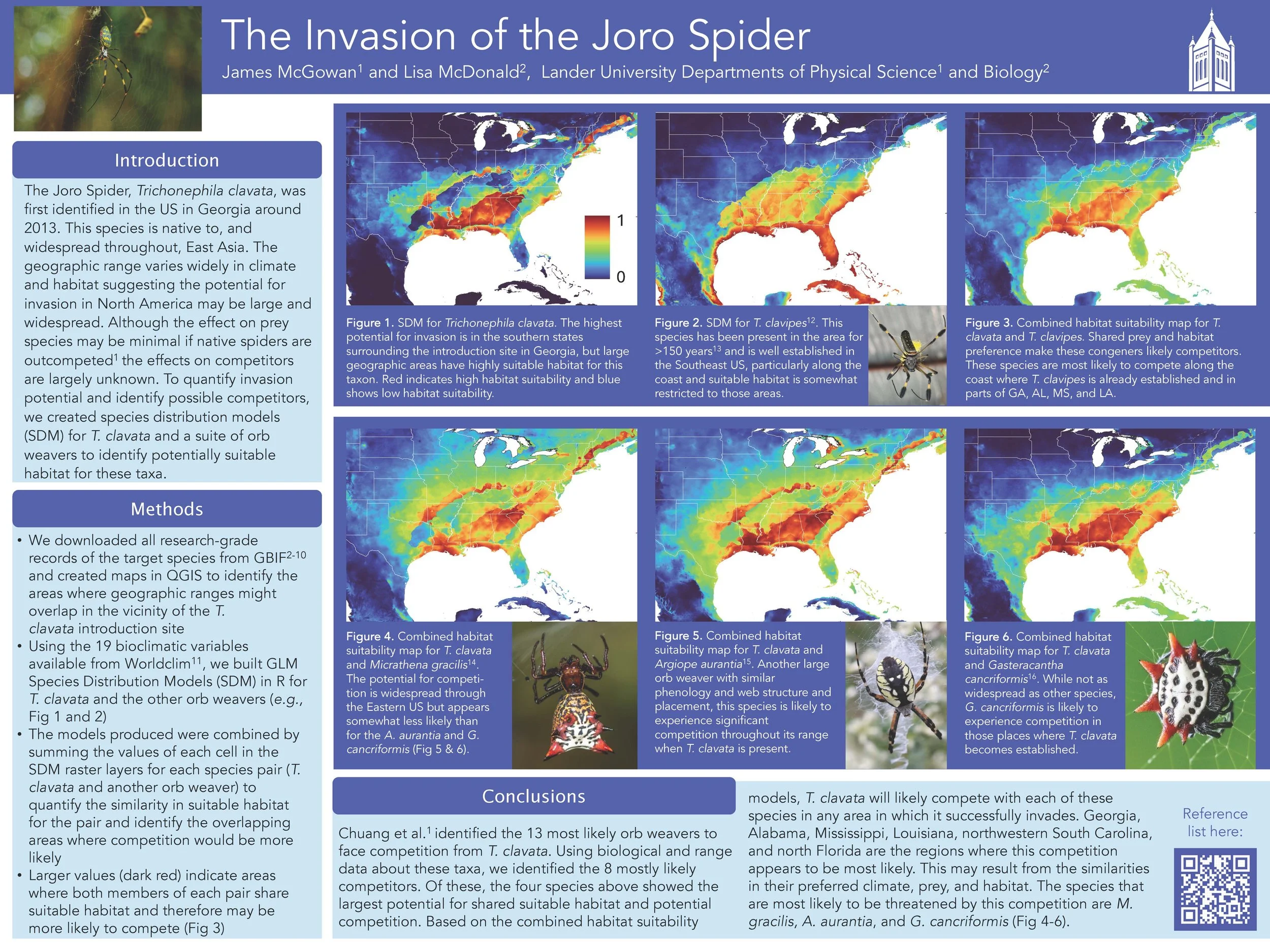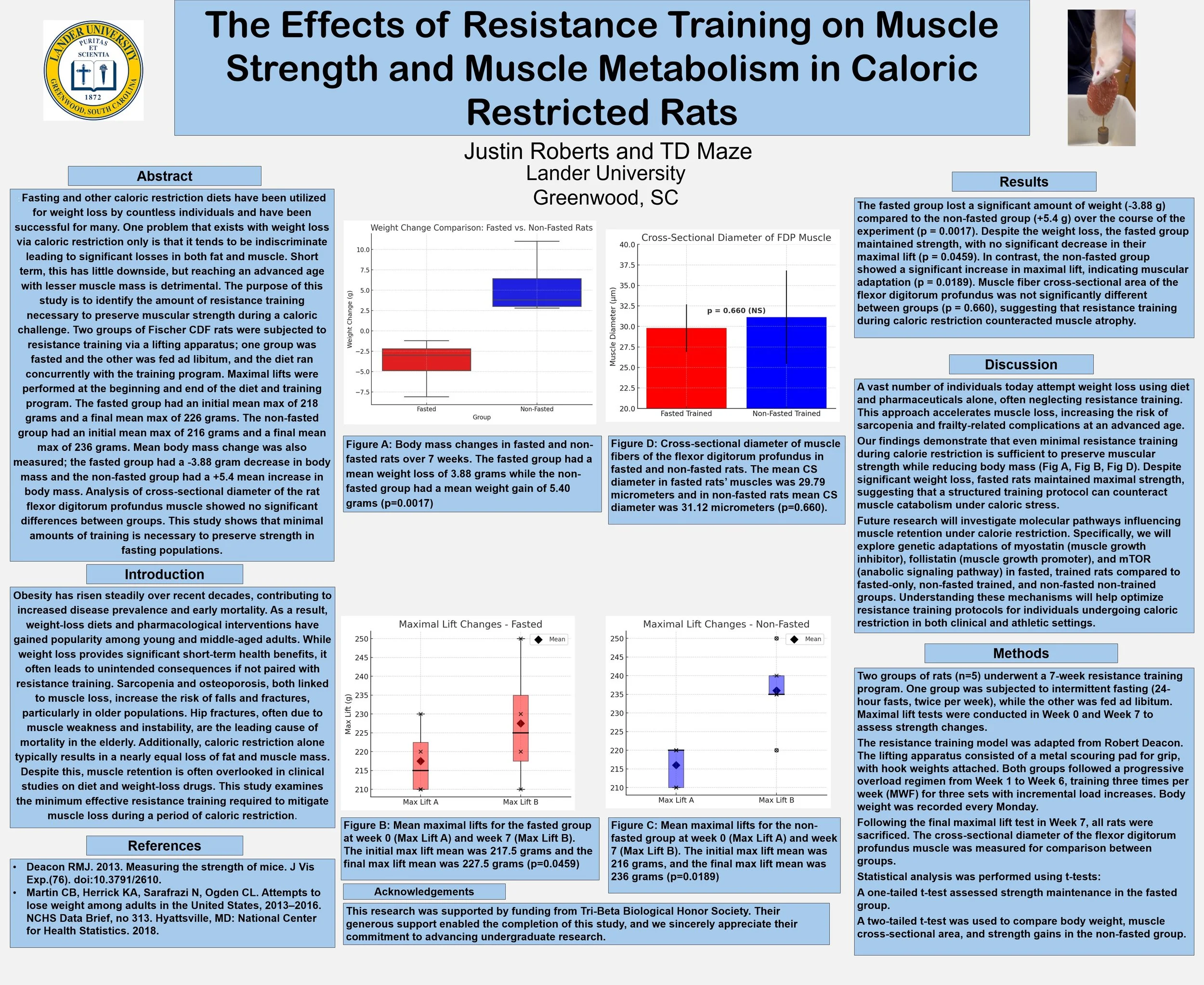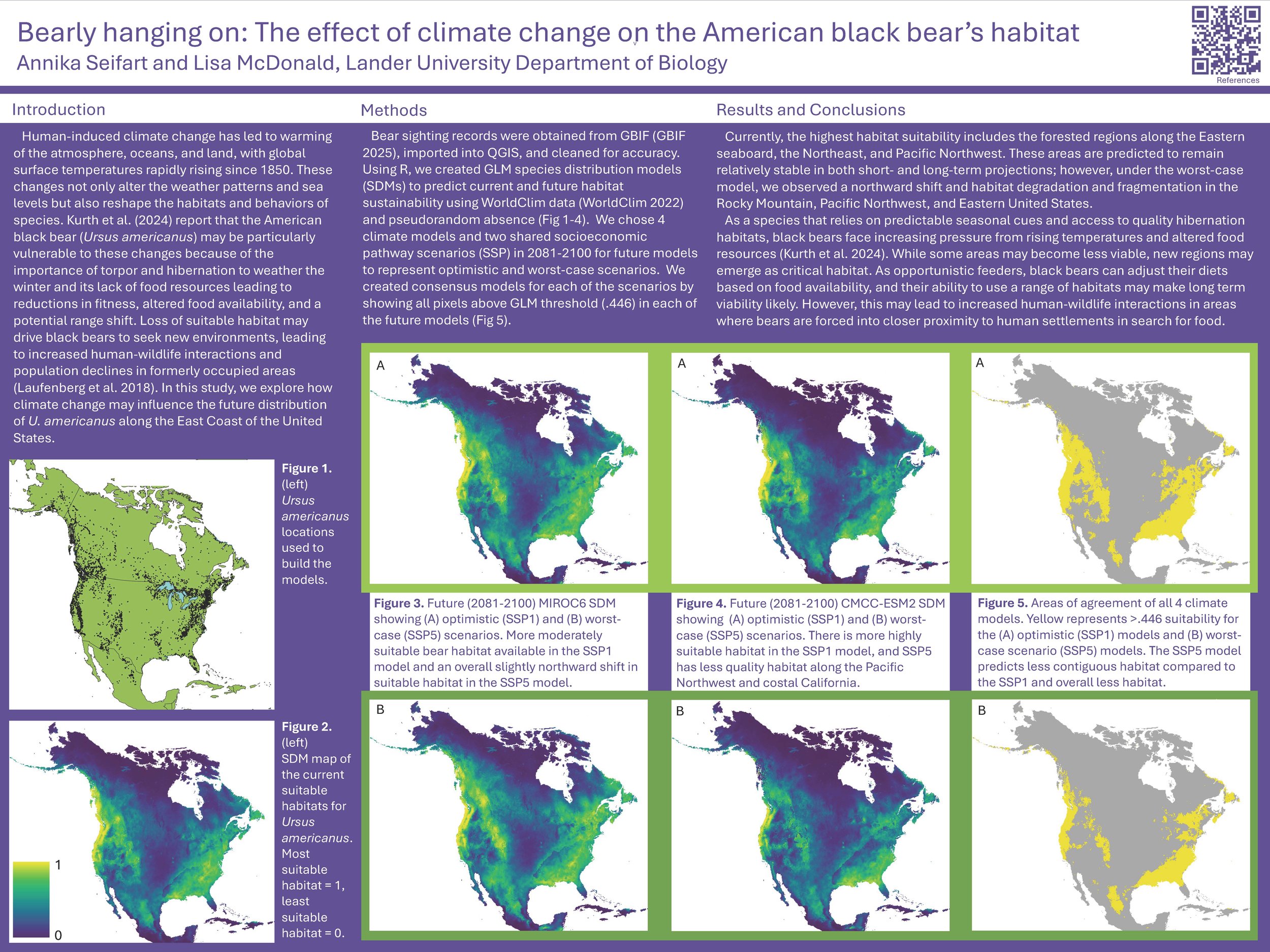Multidisciplinary Poster Session - Biology & Environmental Science
held on April 24, 2025 at the Lander University Academic Symposium
Faculty Sponsors: Kerry Hansknecht - TD Maze - Lisa McDonald - Emily Prince
Presenters: Reegan Magee - James McGowan - Leslie Parker - Justin Roberts - Annika Seifart
Scroll to view all projects!
-
![]()
Reegan Magee
Click here to see the poster in more detail.
Using machine learning to streamline detection in camera trap research
Camera trap research generates massive datasets that require extensive time collecting data from largely empty photos. Artificial intelligence (AI) models can be used effectively to streamline this analysis. Although most machine learning models show significant weakness in identifying species in photos, they can successfully filter out empty images and classify broader categories of observations. We used MegaDetector (version 5B) to batch filter images into folders identifying humans, animals, vehicles, and all possible combinations of these categories. We evaluated the general accuracy of this model compared to data collected manually from the same photos by members of our lab over the last 7 years. Human presence scores (number of disturbances per camera trap day) were calculated for each of our 30 camera trap stations (assessing 3,661,447 photos across our 7 study sites) from manually-collected data and using the MegaDetector model. By removing the empty pictures and including only those with a detection confidence of at least 0.2, the total number of photos to review was reduced by 83.9%. To determine how closely the results from the MegaDetector model resembled our manual calculations of human presence, we calculated the correlation between the two sets of human presence scores. We found a high correlation between these scores (r = .9595, p < .0001), which emphasizes the potential power in using AI models such as this one in place of fully manual evaluation. These results highlight the benefits of AI in aiding data organization and analysis by automating some of the most time-consuming tasks. This frees up large amounts of time that can be more efficiently spent on identifying the target animal taxa in collected photos and analyzing those data to answer important ecological and conservation questions.
Reegan Magee is a sophomore Computer Information Systems major with an emphasis in Software Development and minors in Psychology, Environmental Science, and Data Science. She is from Charleston, SC and a member of the Honors College. She presented at the annual conference of the Association of Southeastern Biologists this year.
-
![]()
James McGowan
Click here to see the poster in more detail.
The Invasion of the Joro Spider
The Joro Spider, Trichonephila clavata, was first identified in the United States in Georgia around 2013. This species is native to, and widespread throughout, East Asia. The large native geographic range varies widely in climate and habitat, and therefore the potential for invasion throughout North America may be equally large. While the environmental effects of T. clavata are still being investigated, one impact is its potential for competition with native orb weavers due to the similar habitat and prey preferences of native orb weavers and T. clavata. Using RStudio, we created species distribution models for T. clavata and a suite of native orb weavers to identify potentially suitable habitats for these spiders. We set out to determine the potential future distribution of the T. clavata throughout the United States and to characterize suitable habitats for the native orb weavers. The spatial rasters we created to visualize our species distribution models were compared using QGIS to determine areas of potential competition. We compared the suitable habitats through the addition of the values in each cell for each pair of raster layers (that of T. clavata and that of one of the native orb weavers). By adding the rasters, we determined areas where both the native orb weavers and the T. clavata show a preference for a particular habitat, and therefore areas of potential competition.
James McGowan is a senior Environmental Science major from Fort Mill, South Carolina. After graduation, he plans to continue working as a wastewater operator and pursue higher licensure.
-
![]()
Leslie Parker
Click here to see the poster in more detail.
Does habitat type affect the diversity and abundance of herpetofauna found under artificial cover objects?
Screening for herpetofauna diversity and abundance is an important means of assessing ecosystem health in order to help guide conservation. Surveys using artificial cover objects are commonly used to monitor these factors efficiently and can greatly increase detection rates of cryptic species. Such surveys are often used to assess restoration success, reveal habitat preferences, and detect population changes, especially for at-risk species. Previous research using artificial cover objects has shown that herpetofauna diversity and abundance are significantly influenced by habitat type. In this study, we will place arrays of 4’ x 4’ plywood coverboards at sites on the premises of Camp Fellowship in Laurens County, SC, in order to compare herpetofauna abundance and diversity among four habitat types: upland forest, floodplain forest, open fields, and forest field edges. We predict that the coverboards placed in floodplain forest habitats will have the highest diversity and abundance while coverboards placed in open fields will have the lowest diversity and abundance.
Leslie Parker is a senior biology major from Lexington, SC. She is a member of the Honors College as well as the Beta Beta Beta Biological Honor Society. Leslie hopes to attend PA School at USC following her graduation from Lander University.
-
![]()
Justin Roberts
Click here to see the poster in more detail.
The Effects of Resistance Training on Muscle Strength and Muscle Metabolism in Caloric Restricted Rats
Fasting and other caloric restriction diets have been utilized for weight loss by countless individuals and have been successful for many. One problem that exists with weight loss via caloric restriction only is that it tends to be indiscriminate leading to significant losses in both fat and muscle. Short term, this has little downside, but reaching an advanced age with lesser muscle mass is detrimental. The purpose of this study is to identify the amount of resistance training necessary to preserve muscular strength during a caloric challenge. Two groups of Fischer CDF rats were subjected to resistance training via a lifting apparatus; one group was fasted and the other was fed ad libitum, and the diet ran concurrently with the training program. Maximal lifts were performed at the beginning and end of the diet and training program. The fasted group had an initial mean max of 218 grams and a final mean max of 226 grams. The non-fasted group had an initial mean max of 216 grams and a final mean max of 236 grams. Mean body mass change was also measured; the fasted group had a -3.88 gram decrease in body mass and the non-fasted group had a +5.4 mean increase in body mass. Analysis of cross-sectional diameter of the rat flexor digitorum profundus muscle showed no significant differences between groups. This study shows that minimal amounts of training is necessary to preserve strength in fasting populations.
Justin Roberts is a graduate from Ninety Six High School and is a senior biology major. Justin works as a peer tutor and academic coach and has presented at the Association of Southeastern Biologists annual convention.
-
![]()
Annika Seifart
Click here to see the poster in more detail.
Bearly Hanging On: The Effect of Climate Change on the American Black Bear’s Habitat
Climate change has created some of the greatest challenges to scientists and to society. Human-induced climate change has warmed the atmosphere, oceans, and land, with global surface temperatures continually rising each decade since 1850. Rising temperatures, specifically warmer winters are reshaping the climate for many species. In particular, the American black bear (Ursus americanus), has the potential to be affected by these changes. A lack of suitable habitat may shift their distribution, they are likely to see changes in food availability and overwintering refugia, and their natural behaviors are likely to be strongly altered. Because U. americanus undergoes hibernation or torpor throughout its range, changes in food availability, temperature, and precipitation patterns could substantially lower fitness if bears are unable to maintain an appropriate metabolic rate throughout the colder parts of the year or find enough food to sustain them through the winter months. We modeled how climate change might affect the distribution of U. americanus along the East Coast of the United States using both a conservative model and a worse-case model of climate change. Using a combination of QGIS and R for spatial analysis and R for statistical modeling, we assessed historical and projected climate trends to identify habitat shifts, areas of potential loss, and zones of expansion. Our findings will illustrate the current species distribution of U. americanus in North America and the possible species distribution under these different climate models. We will present predictions of the species distribution in the short term (~ 20 years) and the longer term (~80 years) to quantify the long-term effects of climate change on this species.
Annika Seifart is a senior biology major with a minor in chemistry and business administration from Jacksonville Florida. She is a four-year member of the Lander University Women’s Soccer team and a member of TriBeta Honor Society. She will graduate from Lander University in May 2025. After graduation, she plans to gain work experience and travel before applying to graduate school.




